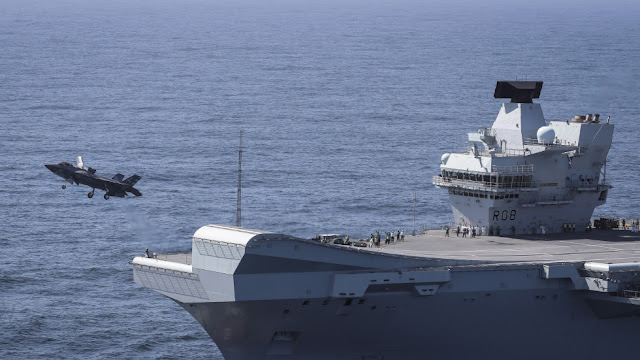
|
| HMS Queen Elizabeth is the flagship of the Royal Navy, and it can launch at least 24 F-35Bs. |
- A squadron from the United States Marine Corps tested its F-35Bs aboard the Queen Elizabeth when it was on its maiden trip.
- That's a military budget of around $54.7 million.
- You can see that the UK is trying to save money by cutting its defense budget, which is now at 3% of GDP, down from 4% in 1980 and 3% in 1990.
- In 2021, Queen Elizabeth commanded a carrier strike force consisting of five British warships, two support ships, and a nuclear-powered attack submarine in the Indo-Pacific.
- Britain has come a long way to finally have its Queen Elizabeth class ships enter service.
It is easy to forget that the United Kingdom also has its own contemporary aircraft carriers because there is so much open source research about the aircraft carriers that belong to China and the United States. The Queen Elizabeth Class is the largest warship that the United Kingdom has ever manufactured; it includes two aircraft carriers. The supercarriers from the United States have a significantly larger crew than these British carriers, which have a significantly smaller crew. The ships each have a crew of 679 sailors, with a total complement of 1,600 when including the air wing troops. The HMS Queen Elizabeth, which is the flagship of the Royal Navy, has the capability to deploy at least 24 F-35B fighter jets. A maximum of 72 aircraft can take off from the carrier at one time.
Both HMS Queen Elizabeth and the Prince of Wales are considered to be part of this class of aircraft carriers. They are the most costly ships ever built by the United Kingdom, coming in at $3.9 billion each. The Queen Elizabeth, often known as "Big Lizzie" by the crew, is a carrier that is 918 feet long and has a displacement of 65,000 tons. The farthest that the carrier is capable of traveling is 10,000 miles. The ship may reach a top speed of 25 knots, which is far slower than the supercarriers used by the United States. However, BAE Systems asserts that the propulsion system has lower operating costs and requires a smaller number of maintenance hours. The Queen Elizabeth Manufacturing Partnership is also known as the Aircraft Carrier Alliance, and BAE Systems is the leading member of this partnership.
The Queen Elizabeth is not powered by nuclear energy; rather, it is equipped with four diesel generators that have a combined capacity of 11 megawatts.
Where Do We Stand With Those F-35s?
"Ski-jump" ramps, which are used by the F-35B stealth fighters for vertical short takeoff and landing, are installed on the aircraft carriers of the Queen Elizabeth class. The Big Lizzie is able to complete short missions because it can launch multiple F-35B fighters into the air in just five minutes and can retrieve one fighter at a time when it is time to land them. Additionally, anti-submarine and early warning helicopters are aboard the Queen Elizabeth. It is possible for the carrier to launch attack helicopters such as the AH-64 Apache.
The United States Marine Corps frequently collaborates with the Royal Navy.
The keel of the ship was set down in 2009, but it did not begin its production process until much later, and it did not begin its sea trials until 2017. A squadron from the United States Marine Corps tested its F-35Bs aboard the Queen Elizabeth when it was on its maiden trip. The purpose of these tests was to assist British navy aviators in better orienting themselves to combat operations involving V-STOL warplanes.
Provide the British military with a variety of different alternatives.
When you think about naval force projection in the modern era, the Royal Navy of the United Kingdom probably isn't the first thing that comes to mind. However, these carriers are cutting-edge and of the highest quality. With those F-35Bs, they are able to defend the nation while also contributing a significant capability to NATO. The United Kingdom has a long history as a maritime nation, and these aircraft carriers of the Queen Elizabeth class are a prime example of how the British navy can continue to be competitive in blue water operations.
The amount spent on defense has decreased.
While other countries spend much more on defense than the United Kingdom (which only spends about 2% of GDP on defense), the latter has earned a reputation for cutting military spending. That's a military budget of around $54.7 million. You can see that the UK is trying to save money by cutting its defense budget, which is now at 3% of GDP, down from 4% in 1980 and 3% in 1990. That the British government is willing to spend so much on aircraft carriers suggests they are not afraid to expand their navy.
The Queen Elizabeth-Class Ships Are Europe's Finest
France possesses the nuclear-powered Charles de Gaulle, but the British have perhaps Europe's best two carriers due to the Russians' problems with their single carrier, the problematic Admiral Kuznetsov, which will be in dry dock until at least 2024. In 2021, Queen Elizabeth commanded a carrier strike force consisting of five British warships, two support ships, and a nuclear-powered attack submarine in the Indo-Pacific. According to the IISS think tank, the cruise lasted for 6.5 months, during which time 1,278 sorties were flown, including 44 combat flights against ISIS in Iraq and Syria.
This spectacular and crucial deployment proves that Queen Elizabeth is ready for battle. Britain has come a long way to finally have its Queen Elizabeth class ships enter service. To add its voice to the conflict, the HMS Prince of Wales will be assisting NATO in the Atlantic Theater.

